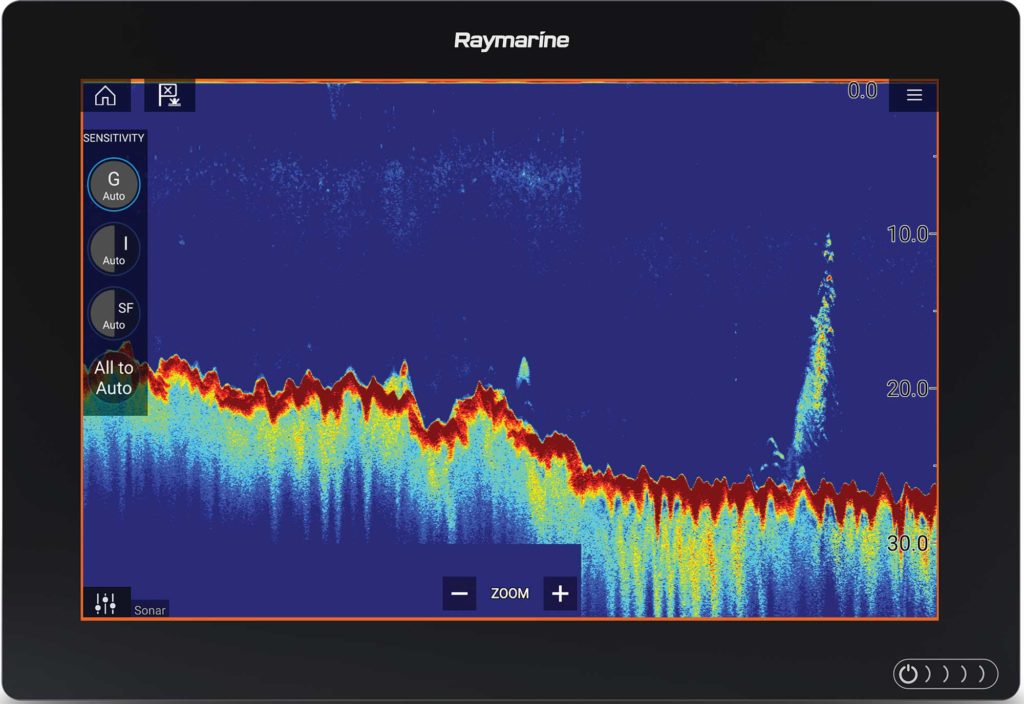
Monitoring marine electronics can be like watching TV at a sports bar. There’s so much going on, you’re not sure where to look.
Put part of the blame on ever-expanding recreational sonar technology that has created more ways than ever to see underwater, including sounders, down imaging, side imaging, forward imaging, 3D imaging and full-circle scanning.
Some systems show where you have gone; others update in real-time, so you know instantly what’s below, to the side or in front of the boat.
Electronics companies pack two or more of these technologies into a single system. For example, Raymarine’s new Axiom Pro multifunction display with RealVision 3D can look down in two different modes, look sideways, and show the underwater world in a three-dimensional format — all using one screen and a single transducer.
Now you have no excuses for getting skunked or running aground. But how do you choose the best technology? We’re here to help you see straight.
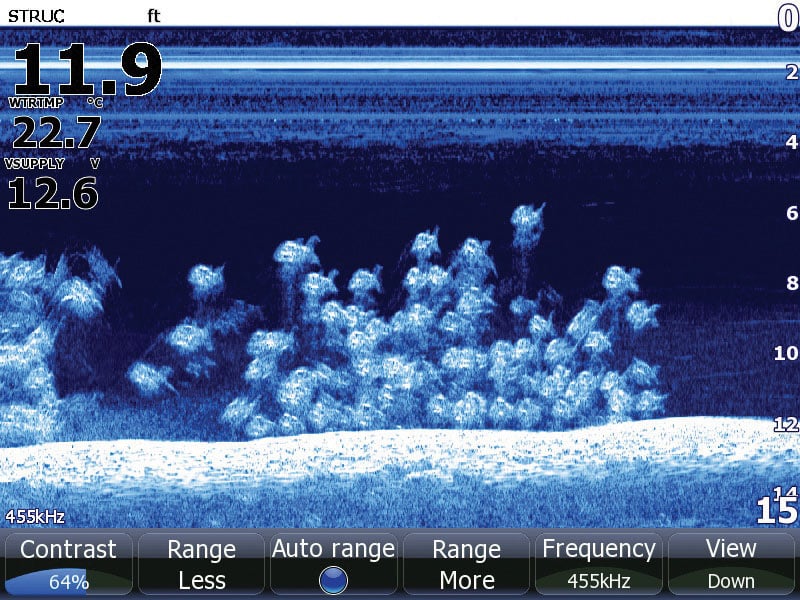
Down and Dirty
Just want to look under the boat? Try an ol’ fashioned fish finder (aka sounder). Equipped with transducers that transmit sound waves vertically in a cone pattern (think upside-down ice-cream cone) and display the returning echoes on a color LCD screen that scrolls from right to left, fish finders remain among the most popular way to peer downward.
But a relatively new technology called chirp (compressed high-intensity radiated pulse) has greatly improved the performance of sounders.
Offered by a host of marine electronics brands, chirp systems operate in much the same way as old-school fish finders but transmit a wide band of frequencies at once versus a single frequency with a traditional system. Then digital signal processing analyzes the chirp returns to paint color images of the underwater world that are very well-defined. There’s also less screen clutter than with fish finders of the past. A wide range of frequency bands, measured in kilohertz, are available for chirp systems. Generally speaking, the greater the water depth, the lower the frequency band is needed, though there are other factors such as power to consider. All things being equal, a high-frequency band of say 150 to 250 kHz, for instance, is good for depths to about 600 feet, while a low-frequency band of 28 to 40 kHz may be needed to read at extreme depths of 3,000 feet or more. Medium-frequency bands of around 85 to 165 kHz provide a compromise for both shallow and deep waters.
Fish finders with transducers that are installed properly can mark the bottom at relatively high speeds — up to 40 mph in some cases, though the slower the boat speed, the better the on-screen images. While sounders are better than ever thanks to chirp, the returns still require a certain level of interpretation to recognize fish, bait schools and bottom composition.
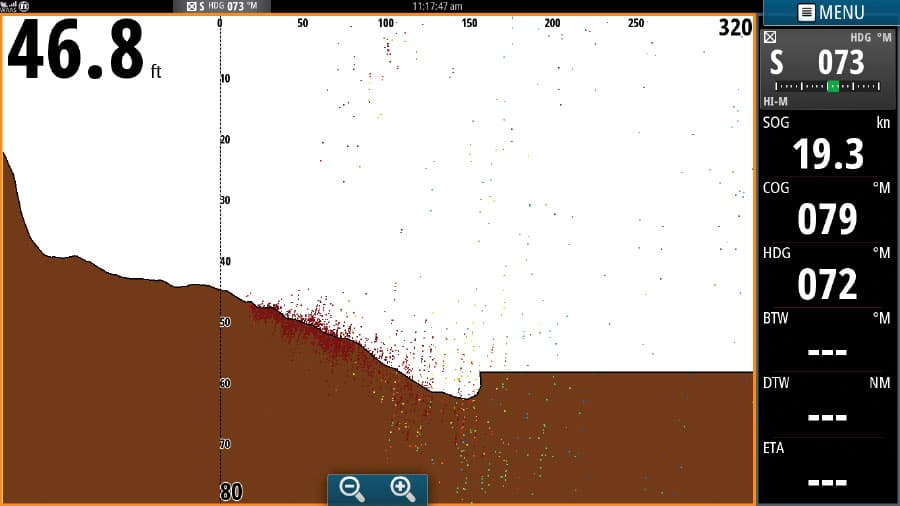
Image Is Everything
There’s another way to look downward. Imaging technology such as Down Imaging (Humminbird), DownScan (Lowrance/Simrad), DownVision (Raymarine) and DownVu (Garmin) uses transducers that electronically scan downward in side-to-side sweeps (think pizza slice). Digital signal processing then assembles these slices into a coherent image as the screen scrolls from right to left.
Frequencies are higher for imaging systems than for fish finders. Raymarine’s DownVision chirps across a high-frequency band of 320 to 380 kHz. Lowrance’s DownScan lets you choose between two frequencies — 455 or 800 kHz. Humminbird’s Mega Down Imaging is the highest frequency of all, transmitting at 1,200 kHz.
Returns from these imaging systems rival those of medical imaging. Fish images can look just like fish. You can discern the branches of submerged trees. Shipwreck images can take on the ghostly profile of a ship.
Yet because of the high frequencies, down-imaging sonar doesn’t possess the depth capabilities of conventional fish finders. Maximum depth for Humminbird’s Mega Down Imaging, for instance, is 125 feet. Raymarine’s DownVision can reach to depths of 600 feet.
Because down imaging samples in relatively thin slices, the systems are not practical to use at high speeds. Keeping speeds under 5 mph helps ensure the best possible target definition. Also, the display images for these systems are monochrome, though the chromatic shade is selectable. Think in terms of the monochrome images you see in medical ultrasounds.
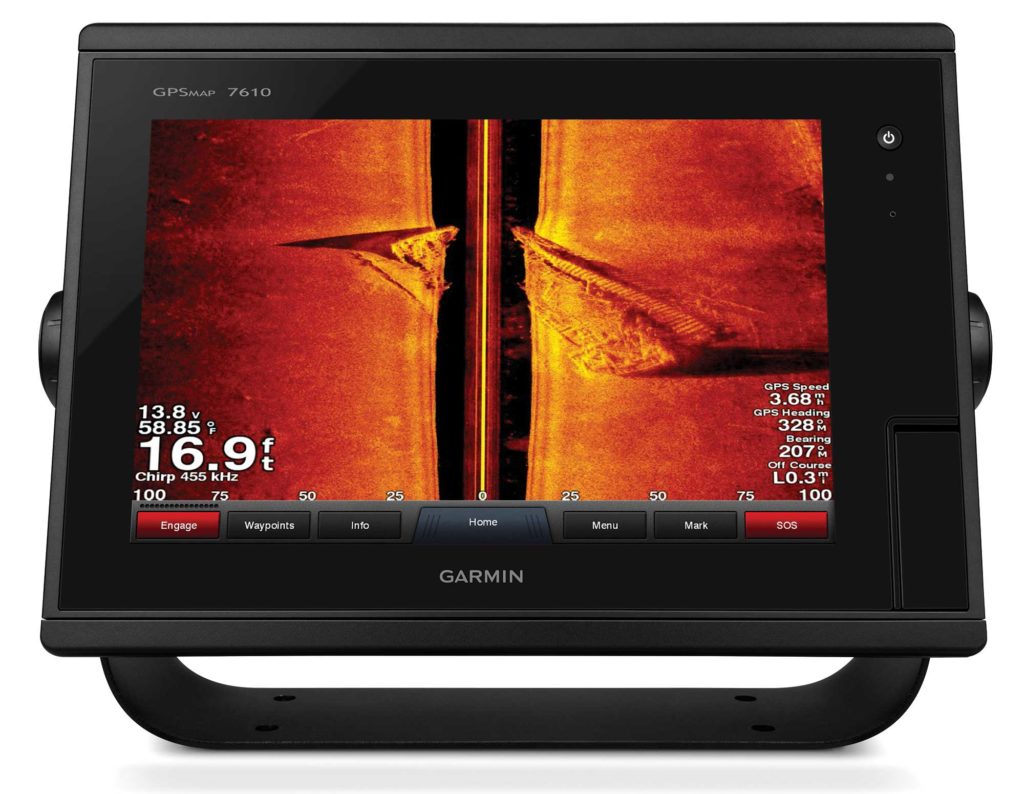
Sideways Glance
The trouble with down-looking systems is that they can only see what’s under your boat. Side imaging, on the other hand, can shoot out to both port and starboard.
Side imaging appeared before down-scanning systems. About 13 years ago, Humminbird introduced the first affordable side-imaging system. Since then, the technology has advanced, and the number of companies that offer this capability has increased to include Garmin (SideVu), Lowrance/Simrad (StructureScan HD SideScan) and Raymarine (SideVision).
Like down imaging, side-imaging systems scan in thin slices. The transducer uses two electronic beams, each shooting sideways and slightly downward. The system puts together pictures of each side on the display as the screen scrolls from the top downward. As with down-scanning systems, images emerge with lifelike, almost eerie clarity, albeit in monochrome shades (again, think ultrasound medical imaging).
Side-imaging systems can reach out to remarkable distances. Garmin’s SideVu, for example, is effective to around 500 feet on each side of the boat. Raymarine’s CHIRP SideVision can reach to distances of 600 feet on each side.
One of coolest features of such systems lies in the ability to create an instant waypoint on your chart plotter for an object or school of fish that is a considerable distance from your boat.
With the Lowrance HDS Carbon MFDs, for example, just tap the school, rock pile or other object of interest on the touchscreen, and the system will create a waypoint with the precise latitude and longitude of that spot. You can do this even after the boat is well past the spot. With the waypoint recorded, you can back-zig over and take a closer look with your fish finder or down-imaging system.
As with down imaging, side-imaging technology works most effectively at boat speeds of under 5 mph. Also, most systems cannot see directly under the boat, and that leaves a blind spot between the side images. However, MFDs allow you to split the screen so you can use both side imaging and the conical fish finder and/or down imaging simultaneously. You won’t a miss a thing.
Full Frontal
Some systems can also look forward to help you avoid shoals or spot fish off the bow of the boat. This includes Garmin’s Panoptix Forward technology.
With Garmin’s PS31 transom-mount transducer and a compatible Garmin MFD, you can see as far as 300 feet ahead of the boat. A beam sweeps at 417 kHz while aimed forward and slightly downward. You can also use the PS31 with a special bow-mounted trolling-motor bracket to scan in any direction you want while fishing.
Choose Panoptix LiveVu Forward mode for color images of the bottom and fish. It is continually refreshed in a two-dimensional format. You can actually track fish and lures as they move through the water. The RealVu 3D mode creates a three-dimensional view of the bottom, structure and fish that updates every one to four seconds. In other words, the image does not scroll, but rather the whole screen refreshes.
Garmin and Simrad also have systems designed primarily to keep skippers apprised of changes in depth and obstructions with a continuously updated 2D display of what’s ahead. Garmin’s Panoptix FrontVu uses the PS51TH through-hull 417 kHz transducer, while Simrad’s uses the ForwardScan through-hull 180 kHz transducer for its forward-looking sonar. Both the Garmin and Simrad will reach out to 8x the current bottom depth.
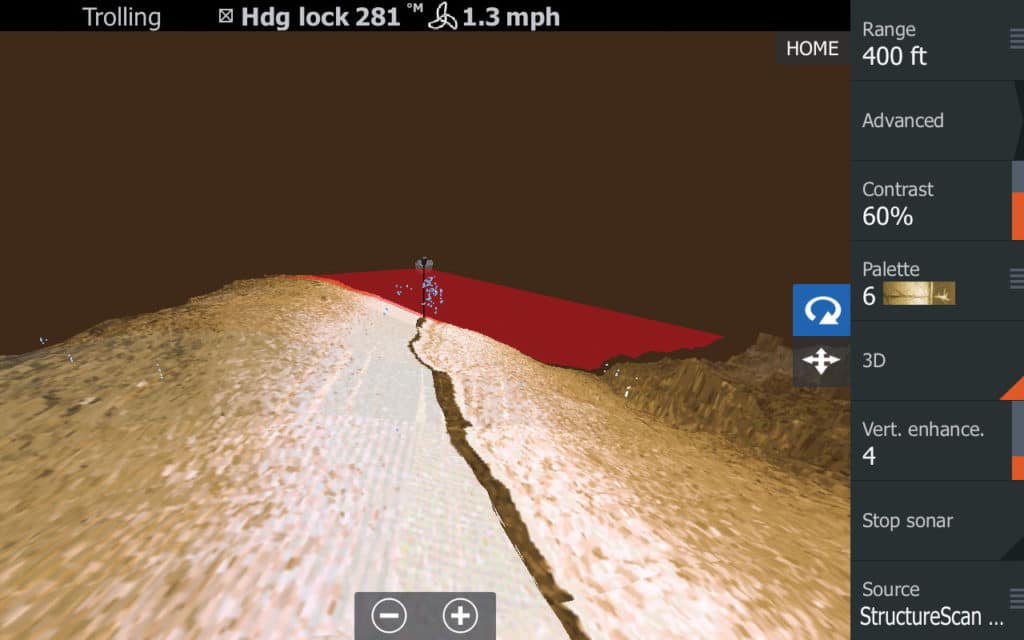
Three-Dimensional
While Garmin has RealVu 3D, Furuno, Lowrance, Raymarine and Simrad also offer three-dimensional representations of the underwater world and its inhabitants.
Lowrance and Simrad do this with an add-on module called Structure-Scan 3D. Raymarine offers this with RealVision 3D in its Axiom and Axiom Pro MFDs. Such 3D modes are actually software-enhanced displays of the combined down- and side-imaging sonar returns.
The same software enhancements let you manipulate the 3D representation with the touchscreen to view the image from virtually any perspective that you choose. Both RealVision 3D and StructureScan 3D let you zoom, pan, tilt and rotate the image. You can even look at it from underneath.
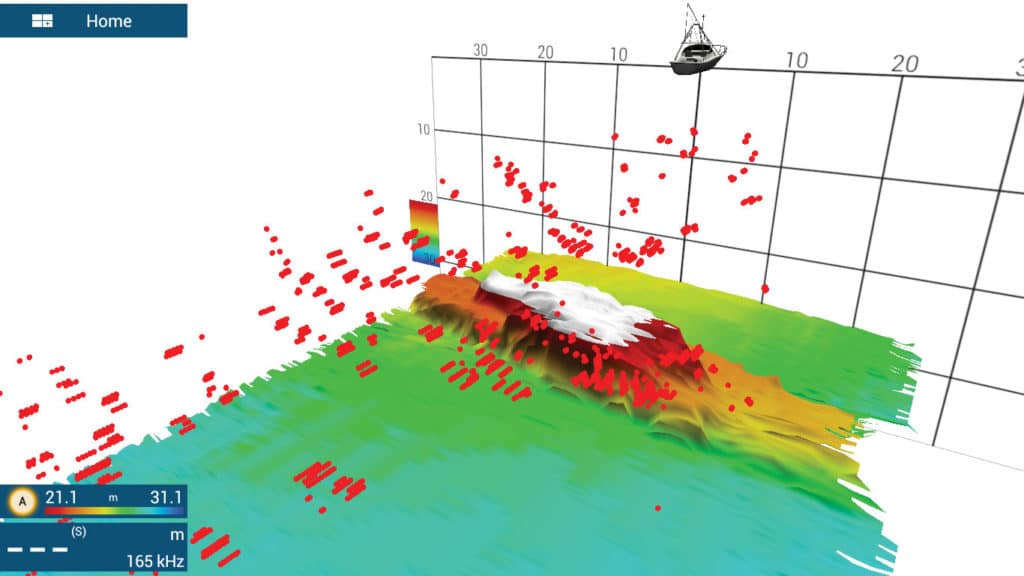
Three-dimensional modes also add color elements to the imaging sonar displays. Fish suspended in the water column appear in a different color from the otherwise monochrome imaging of the bottom contours, allowing you to more easily distinguish such targets.
Garmin’s transom-mount Panoptix PS30 transducer can deliver the RealVu 3D Down and RealVu 3D Historical modes when matched with a compatible Garmin MFD. RealVu 3D Down allows you to view the history of one transducer sweep while your boat is stationary, while RealVu 3D Historical creates a three-dimensional view of what has passed under the hull. This system also offers LiveVu Down for real-time imaging and the ability to see fish moving toward or away from your boat.
Furuno’s DFF3D scanning sonar system includes a variety of display modes, one of which is a three-dimensional view of the underwater world. DFF3D uses an add-on module networked with Furuno’s NavNet TZtouch and TZtouch2 MFDs. A special multibeam transducer scans 120 degrees in a continuous swath (with no blind spot under the boat), and in the 3D History mode paints a color three-dimensional image. Fish are shown in a distinctive shade, and you can also set the color palette to depict the depths of bottom contours. The DFF3D reads out to 650 feet on both sides of the boat and up to 980 feet straight down.
The DFF3D system can also image in real time. The cross-section display mode continually updates as the sonar beam sweeps from side to side.
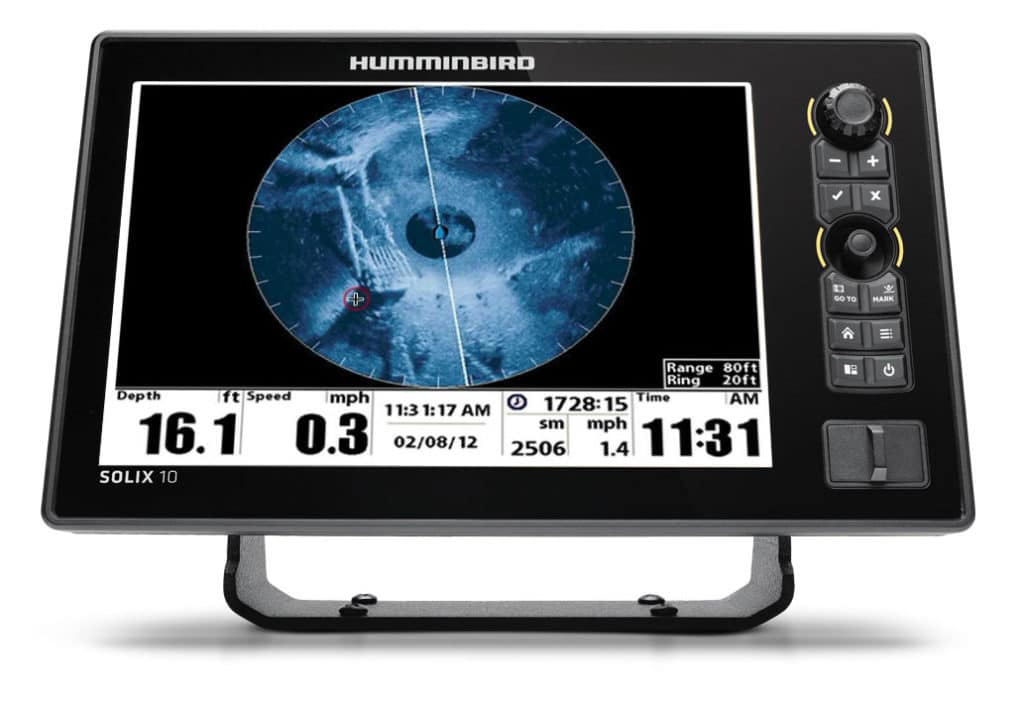
Full Circle
There’s a number of ways to image the underwater world in a full circle around the boat. One of the most affordable is Humminbird’s 360 Imaging system. It uses a retractable transducer that electronically scans 360 degrees and will reach out to scan up to 150 feet from the boat.
When matched with a compatible Humminbird MFD, the system updates the screen with every rotation of the transducer beam. Returns are depicted in a two-dimensional yet lifelike, monochromatic image similar to the look of Humminbird’s Down Imaging and Side Imaging systems. You can also narrow the scan to any sector, such as a 45-degree sector ahead of the boat. The narrower the sector, the faster the screen updates.
The transducer must be below the bottom of the boat to operate effectively. One option is a motorized transom-mount pole mechanism that lets you deploy to a predetermined depth and then retract the transducer at the press of a finger. You can also mount a transducer to a Minn Kota bow-mounted trolling motor.
As with other imaging systems, the slower the boat speed, the more detailed the images. Also, even moderately high speeds can damage or tear loose the transducer pole or trolling motor, lending impetus to the need to keep it under 5 mph.
The Humminbird system will fit on boats of 20 feet in length or less. But more powerful, stand-alone scanning sonar systems are available from companies such as Furuno and Koden. These are designed primarily for large vessels that fish offshore.
Residing in tubes as large as 8 inches in diameter, the sonar-transducer assembly deploys from within a sea chest and protrudes well below the hull when in use, then retracts for running at higher speeds.
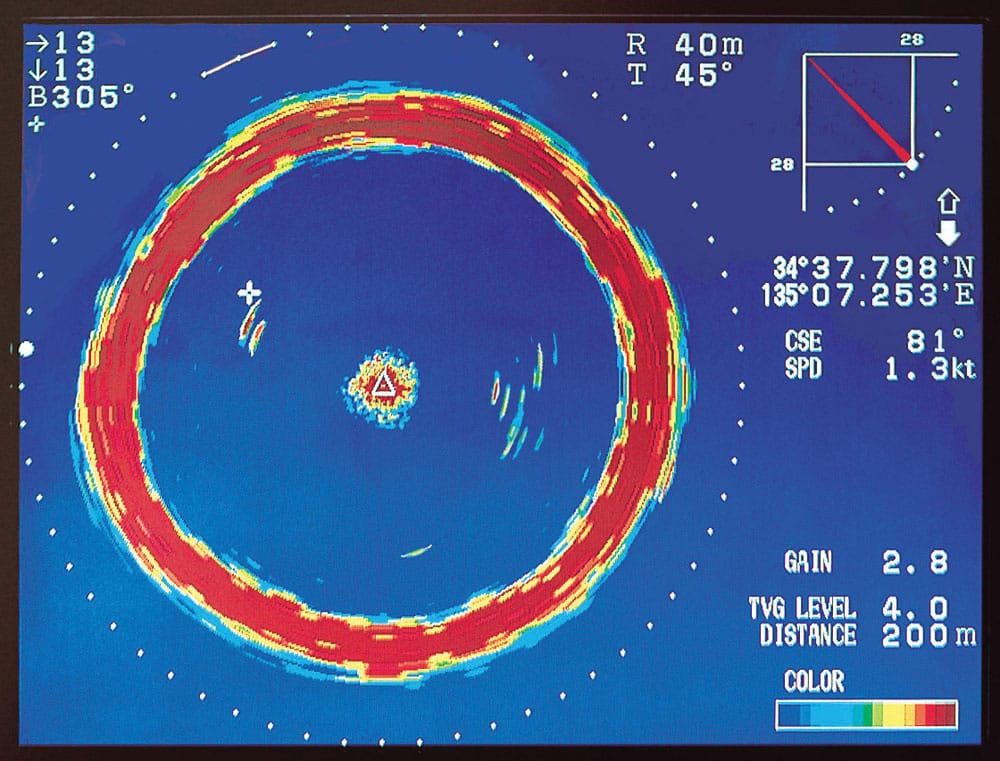
In some systems, the transducer mechanically rotates as it transmits. With more-advanced systems such as the Furuno CSH-8L Mark 2, the transducer is stationary. It’s equipped with an array of 420 elements that transmit electronically, resulting in a sonar image that’s updated in real time. You can look 360 degrees around the boat and as far out as 6,000 feet with some systems.
Skippers who possess experience in using sonar can easily interpret the returns, but newcomers might find it difficult, particularly with sonar using mechanically driven transducers, which might take more than a minute to make a full-circle sweep, or “train,” as it is called. Veteran captains have learned to listen to the audio of the sonar’s “tap, tap, tap.” When a target appears, the sound becomes more of a rattle, alerting the captain to check the display.
The biggest downside to these systems is the price. One of the least expensive is Furuno’s CH-270 that retails for $14,000, excluding installation, which can be fairly pricey. The Furuno CSH-8L real-time sonar sells for $75,000, excluding installation. By comparison, Humminbird’s 360 Imaging system costs about $1,280.
There are also space considerations. Unless you have a boat that’s at least 35 to 40 feet in length, you won’t have room for a stand-alone scanning sonar system. Not to worry. There are plenty of other ways to see underwater. And with this guide to sonar technology, you now have a good idea of where to look.








